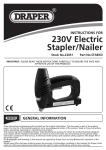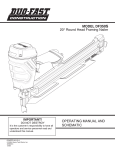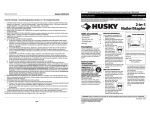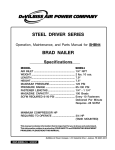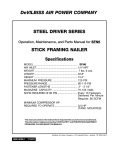Download DeVilbiss DAPC Operator`s manual
Transcript
Model ANK20 OPERATOR’S MANUAL NAILER/STAPLER KIT SAFETY ● ASSEMBLY ● OPERATION ● MAINTENANCE ● TROUBLESHOOTING ● ESPAÑOL Read Operator’s Manual. Do not operate equipment until you have read this Operator’s Manual for Safety, Assembly, Operation, and Maintenance Instructions. D24156 Rev. 0 6/11/01 TABLE OF CONTENTS Safety Guideline-Definitions . . . . . . . . . . . . . . . . . . . . . . . . . . . . . . . .2 Important Safety Instructions . . . . . . . . . . . . . . . . . . . . . . . . . . . . .2-5 Lubrication and Maintenance . . . . . . . . . . . . . . . . . . . . . . . . . . . . .6-7 Recommended Hook-up . . . . . . . . . . . . . . . . . . . . . . . . . . . . . . . . . .7 Contact Trip Safety Mechanism . . . . . . . . . . . . . . . . . . . . . . . . . . .8-9 Loading the Tool . . . . . . . . . . . . . . . . . . . . . . . . . . . . . . . . . . . . . .9-10 Operating the Tool . . . . . . . . . . . . . . . . . . . . . . . . . . . . . . . . . . . . . .10 Clearing a Jam From the Tool . . . . . . . . . . . . . . . . . . . . . . . . . . .11-12 Troubleshooting . . . . . . . . . . . . . . . . . . . . . . . . . . . . . . . . . . . . . . . .13 Specifications . . . . . . . . . . . . . . . . . . . . . . . . . . . . . . . . . . . . . . . . . .14 Fasteners . . . . . . . . . . . . . . . . . . . . . . . . . . . . . . . . . . . . . . . . . . . . .15 Warranty . . . . . . . . . . . . . . . . . . . . . . . . . . . . . . . . . . . . . . . . . . . . .16 SAFETY GUIDELINES - DEFINITIONS This manual contains information that is important for you to know and understand. This information relates to protecting YOUR SAFETY and PREVENTING EQUIPMENT PROBLEMS. To help you recognize this information, we use the symbols below. Please read the manual and pay attention to these sections. SAFETY and PREVENTING EQUIPMENT PROBLEMS. To help you recognize this information, we use the symbols below. Please read the manual and pay attention to these sections. Indicates an imminently hazardous situation which, if not avoided, will result in death or serious injury. Indicates a potentially hazardous situation which, if not avoided, may result in minor or moderate injury. Indicates a potentially hazardous situation which, if not avoided, could result in death or serious injury. Used without the safety alert symbol indicates a potentially hazardous situation which, if not avoided, may result in property damage. IMPORTANT SAFETY INSTRUCTIONS Some dust created by power sanding, sawing, grinding, drilling, and other construction activities contains chemicals known (to the State of California) to cause cancer, birth defects or other reproductive harm. Some example of these chemicals are: l lead from lead-based paints l crystalline silica from bricks and cement and other masonry products l arsenic and chromium from chemically-treated lumber Your risk from these exposures varies, depending on how often you do this type of work. To reduce your exposure to these chemicals: work in a well ventilated area, and work with approved safety equipment, always wear MSHA/NIOSH approved, properly fitting face mask or respirator when using such tools. When using air tools, basic safety precautions should always be followed to reduce the risk of of personal injury. D24156 2 - Eng SAVE! IMPORTANT SAFETY INSTRUCTIONS SAVE! IMPROPER OPERATION OR MAINTENANCE OF THIS PRODUCT COULD RESULT IN SERIOUS INJURY AND PROPERTY DAMAGE. READ AND UNDERSTAND ALL WARNINGS AND OPERATING INSTRUCTIONS BEFORE USING THIS EQUIPMENT.WHEN USING AIR TOOLS, BASIC SAFETY PRECAUTIONS SHOULD ALWAYS BE FOLLOWED TO REDUCE THE RISK OF PERSONAL INJURY. HAZARD RISK OF EYE OR HEAD INJURY WHAT COULD HAPPEN HOW TO PREVENT IT • Air powered equipment and power tools are capable of propelling materials such as fasteners, metal chips, saw dust, and other debris at high speed, which could result in serious eye injury. • Always wear ANSI approved Z87.1 safety glasses with side shields. • Never leave operating tool unattended. Disconnect air hose when tool is not in use. • Compressed air can be hazardous. The air stream can cause injury to soft tissue areas such as eyes, ears, etc. Particles or objects propelled by the stream can cause injury. • For additional protection use an approved face shield in addition to safety glasses. • Tool attachments can be come loose or break and fly apart propelling particles at the operator and others in the work area. RISK OF FIRE OR EXPLOSION • Abrasive tools such as sanders and grinders, rotating tools such as drills, and impact tools such as nailers, staplers, wrenches, hammers, and reciprocating saws are capable of generating sparks which could result in ignition of flammable materials. • Exceeding the maximum pressure rating of tools or accessories could cause an explosion resulting in serious injury. • Make sure that any attachments are securely assembled. • Never operate tools near flammable substances such as gasoline, naptha, cleaning solvents, etc. • Work in a clean, well ventilated area free of combustible materials. • Never use oxygen, carbon dioxide or other bottled gases as a power source for air tools. • Use compressed air regulated to a maximum pressure at or below the rated pressure of any attachments. RISK OF LOSS OF HEARING • Long term exposure to noise produced from the operation of air tools can lead to permanent hearing loss. • Always wear ANSI S3.19 hearing protection. • Abrasive tools, such as grinders, sanders, and cut-off tools generate dust and abrasive materials which can be harmful to human lungs and respiratory system. • Some materials such as adhesives and tar, contain chemicals whose vapors could cause serious injury with prolonged exposure. • Always wear MSHA/NIOSH approved, properly fitting face mask or respirator when using such tools. RISK TO BREATHING INHALATION HAZARD 3 - Eng • Always work in a clean, dry, well ventilated area. D24156 HAZARD RISK OF INJURY D24156 WHAT COULD HAPPEN HOW TO PREVENT IT • Tools left unattended, or with the air hose attached can be activated by unauthorized persons leading to their injury or injury to others. • Remove air hose when tool is not in use and store tool in secure location away from reach of children. • Air tools can propel fasteners or other materials throughout the work area. • Use only parts, fasteners, and accessories recommended by the manufacturer. • Keep work area clean and free of clutter. Keep children and others away from work area during operation of the tool. • Keep work area well lit. • Air tools can become activated by accident during maintenance or tool changes. • Remove air hose to lubricate or add grinding attachments, sanding discs, drills, etc. to the tool. • Never carry the tool by the hose. • Avoid unintentional starting. Don't carry hooked-up tool with finger on trigger. • Repair servicing should be done only by an authorized service representative. • Air tools can cause the workpiece to move upon contact leading to injury. • Use clamps or other devices to prevent movement. • Loss of control of the tool can lead to injury to self or others. • Never operate tool while under the influence of drugs or alcohol. • Don't overreach. Keep proper footing and balance at all times. • Keep handles dry, clean, and free from oil and grease. • Stay alert. Watch what you are doing. Use common sense. Do not operate tool when you are tired. • Poor quality, improper, or damaged tools such as grinding wheels, chisels, sockets, drills, nailers, staplers, etc., can fly apart during operation, propelling particles throughout the work area causing serious injury. • Always use tool attachments rated for the speed of the power tool. • Never use tools which have been dropped, impacted or damaged by use. • Use only impact grade sockets on an impact wrench. • Do not apply excessive force to the tool – let the tool perform the work. • Using air tools to attach electrical wiring can result in electrocution or death. • Never use nailer/staplers to attach electrical wiring while energized. • Fasteners coming in contact with hidden electrical wiring could cause electrocution or death. • Never use nailer/staplers to attach material to areas that may contain hidden electrical wires. 4 - Eng HAZARD RISK OF INJURY (continued) WHAT COULD HAPPEN Fasteners could ricochet or be propelled causing serious injury or property damage. HOW TO PREVENT IT Never point discharge of tool at self or others. Do not pull trigger unless tool contact safety device is against work surface. Never attempt to drive fasteners into hard surfaces such as steel, concrete, or tile. Take care to avoid driving a fastener on top of another fastener. Position tool carefully so that fasteners will be delivered to the proper location. RISK OF ENTANGLEMENT RISK OF CUT OR BURNS • Tools which contain moving elements, or drive other moving tools, such as grinding wheels, sockets, sanding discs, etc. can become entangled in hair, clothing, jewelry and other loose objects, resulting in severe injury. • Never wear loose fitting clothes, or apparel which contains loose straps or ties, etc. which could become entangled in moving parts of the tool. • Remove any jewelry, watches, identifications, bracelets, necklaces, etc. which might become caught by the tool. • Keep hands away from moving parts. Tie up or cover long hair. • Always wear proper fitting clothing and other safety equipment when using this tool. • Tools which cut, shear, drill, staple, punch, chisel, etc. are capable of causing serious injury. • Keep the working part of the tool away from hands and body. 5 - Eng D24156 LUBRICATION AND MAINTENANCE Do not store the tool in cold weather. Frost or ice can form on the operating valves or mechanisms and the tool may not operate correctly. In cold weather operation (near or below freezing), DO NOT USE a permanent antifreeze such as ethylene glycol for a cold weather lubricant. This type of anitfreeze will damage o-rings and seals of the tool. NOTE: Proper lubrication is the owner's responsibility. Failure to lubricate the tool properly will dramatically shorten the life of the tool and void your warranty. Your tool requires lubrication before you use it for the first time and before and after each additional use. If an Oiler is used, manual lubrication through the air inlet is not required on a daily basis. Lubrication prevents wear and prevents rust from forming. 1. 2. Disconnect the air supply from the tool before manually lubricating. Turn the tool so the air inlet is facing up and put one drop of DeVilbiss Air Tool Oil (supplied) into the air inlet. High speed spindle oil, such as Unocal RX22, or 3-in-1 oil can be used, DO NOT USE detergent oil or additives. Figure 1 Operate the tool briefly after adding oil. (See Figure 1) Keep out of the reach of children. If taken internally, do not induce vomiting, call a doctor immediately or contact your local poison control center. DO NOT OVER LUBRICATE AIR TOOL. 3. Wipe off excessive oil at the exhaust. NOTE: Many air tool users find it convenient to use an Oiler to help provide oil circulation through tool. An Oiler also increases the efficiency and useful life Regulator of the tool. An oiler is recommended for tools that receive heavy or constant use. Check oil level in the oiler daily. Air Flow (See Figure 2) Many air tool users find it convenient to use a Filter to remove liquid and solid Filter Oiler impurities which can rust or "gum up" internal parts of the tool. A Filter also inFigure 2 creases the efficiency and useful life of the tool. Filter will need to be properly maintained, see maintenance information supplied with filter for proper maintenance care. (See Figure 2) D24156 6 - Eng NOTE: Excessive oil will damage o-rings and seal of tool. If in-line oiler is used, manual lubrication through the air inlet is not required on a daily basis. Do not use any type of flammable gases or oxygen as a power source for the tool. Use filtered, lubricated, regulated compressed air only. Use of compressed gas instead of compressed air may cause the tool to explode and cause death or serious personal injury. Do not use a check valve or any other fittings which will allow air to remain in the tool. Serious personal injury or property damage could occur. Use a Pressure Regulator on your compressor with an operating pressure of 0-125 PSI. A Pressure Regulator is required to control the operating pressure of your tool. Refer to the label on your nailer/stapler for the maximum P.S.I. Never carry the tool by the hose or pull the hose to move the tool or a compressor. Keep hoses away from heat, oil, and sharp edges. Replace any damaged, weak or worn hoses. The air compressor must be able to maintain a minimum of 65 PSI when the tool is being used. An inadequate air supply can cause a loss of power or inconsistent operation. IMPORTANT: Always connect the quick connect body to the air hose. Never connect the quick connect body to the tool. RECOMMENDED HOOK-UP The following illustration shows the proper hook-up which will help prolong the life of the Tool. QUICK CONNECT BRAD NAILER/ QUICK OILER BODY STAPLER CONNECT PLUG QUICK (Supplied with Tool) CONNECT PLUG FILTER AIR COMPRESSOR AIR HOSE (3/8" I.D.) QUICK CONNECT BODY 7 - Eng REGULATOR D24156 CONTACT TRIP SAFETY MECHANISM Never keep the trigger pulled on contact trip tools when carrying or holding the tool. Death or a serious puncture wound could occur if the contact trip bumps something or someone. Do not hold the tool against the work surface with extra force. Allow the tool to drive the fastener. 1. 2. 3. 4. It It It It Do not use the contact trip mechanism as a means of discharging a fastener because: could result in personal injury could result in an accidental release of a fastener. may cause damage to the mechanism. could result in improper placement of fastener in work piece. Keep your hands and body away from the fastener discharge area of the tool. Serious personal injury or property damage could occur. Your Nailer/Stapler is a contact trip operated tool. When the operator depresses the contact trip safety mechanism against the work surface and then pulls the trigger, a fastener will be driven. OPERATING A CONTACT TRIP TOOL: 1. Requires finger to be off the trigger and the nose of the Tool to be placed on the work surface. 2. The contact trip safety mechanism is then depressed against the work surface and the trigger pulled to drive a fastener. 3. The trigger is released after each fastener is driven. 4. Move the tool to the next desired fastener location and repeat the procedure above. CHECKING THE OPERATION OF CONTACT TRIP SAFETY MECHANISM Check the operation of the contact trip safety mechanism often. Do not use the tool if the contact trip safety mechanism is not working correctly. 1. 2. 3. 4. 5. Disconnect the air supply from the tool. Remove all fasteners from the magazine. Make sure the trigger and contact trip safety mechanism move up and down without any sticking or binding. Reconnect air supply to the tool. Depress the contact trip safety mechanism against the work surface without pulling the trigger. The tool must not cycle. Do not use the tool if a cycle occurs. D24156 8 - Eng 6. 7. Hold the tool clear of the work surface. The contact trip safety mechanism should return to its original down position. Pull the trigger. The tool must not cycle. Do not use the tool if a cycle occurs. Depress the contact trip safety mechanism against the work surface. Pull the trigger. The tool must cycle. Make sure not to pull the trigger or depress the contact trip safety mechanism when connecting the tool to an air compressor. Serious personal injury or property damage can occur if the tool cycles. LOADING THE TOOL Disconnect tool from air supply before adjusting, clearing jams, servicing, relocating or during non-operation. Failure to do so could result in serious injury or property damage. Never place your hand or any part of your body in the fastener discharge area of the tool when air supply is connected to the tool. Serious personal injury may occur. a. b. c. d. e. Handle the tool carefully. Respect the tool as a working implement and always assume the tool contains fasteners: Never use the tool as a toy and engage in horseplay. Never aim or point the tool at anyone. The tool may contain fasteners. Always keep people and animals at a safe distance from the work area in case of accidental discharge of fasteners. Never pull the trigger unless the nose of the tool is against the work surface. Do not pull the trigger or depress the contact trip when loading the tool. NOTE: See specification and fastener section for fastener information. Loading the Tool 1. 2 Disconnect air hose. Depress magazine latch and slide magazine open. Magazine Latch Magazine Latch Stapler Brad Nailer 9 - Eng D24156 3. Insert a stick of fasteners into the magazine. Make sure fasteners are not dirty or damaged. Use DeVilbiss fasteners or equivalent for proper fastener performance. Brad Nailer Stapler NOTE: On brad nailer make sure the pointed ends of the fasteners are loaded with the points downward. 4. Slide magazine until it locks in place. OPERATING THE TOOL READ THIS MANUAL AND UNDERSTAND ALL SAFETY WARNINGS AND INSTRUCTIONS BEFORE OPERATING TOOL. Protect your eyes and ears. Wear Z87.1 safety glasses with side shields. Wear hearing protection. Employers and users are responsible for ensuring the user or anyone near the tool uses the prescribed safety equipment. 1. Add one drop of DeVilbiss Air Tool Oil (supplied) into the air inlet. High speed spindle oil, such as Unocal RX22, or 3-in1 oil can be used. Keep out of the reach of children. If taken internally, do not induce vomiting, call a doctor immediately or contact your local poison control center. 2. Connect the Tool to the air supply. 3. Regulate the air pressure to obtain a minimum of 75 PSI at the tool. 4. Set air pressure regulator to 75 PSI and test for proper fastener penetration by driving fasteners into a sample piece of wood. If the fasteners do not achieve the desired penetration, adjust the air pressure to a lower or higher setting until the desired penetration is achieved. Do not exceed the maximum operating PSI at the tool. NOTE; Check and replace any damaged or worn components on the tool. The safety warning labels on the tool must also be replaced if they are not legible. D24156 10 - Eng CLEARING A JAM FROM THE TOOL Disconnect tool from air supply before adjusting, clearing jams, servicing, relocating or during non-operation. Failure to do so could result in serious injury or property damage. FASTENER JAM INSIDE MAGAZINE: 1. Disconnect tool from air hose. 2. Release the magazine latch to open the magazine. Magazine Latch Magazine Latch Brad Nailer Stapler 3. Remove jammed fasteners. 4. Reload fasteners into magazine. Refer to Loading the Tool section in this manual. FASTENER JAMMED IN FASTENER DISCHARGE AREA: For Stapler 1. Disconnect tool from air hose. 2. Release the magazine latch to open Magazine Latch the magazine. 3. Remove fasteners from magazine. 4. Loosen the three screws on the driver guide cover. 5. Remove the two screws holding the driver guide cover to the gun body. IMPORTANT: Before removing driver guide cover note the orientation of all parts. 6. Slide driver guide cover out until jammed fastener is visible Loosen 7. Using pliers remove fasteners. 8. Slide drive guide cover into place and Remove line up holes in spring retainer and bracket. Replace screws. 9. Tighten all screws securely. 10. Reload fasteners into magazine. Refer to Loading the Tool section in this manual. 11 - Eng D24156 For Brad Nailer 1. Disconnect tool from air hose. 2. Release the magazine latch to open Magazine Latch the magazine. 3. Remove fasteners from magazine. 4. Remove the three screws on the driver guide cover. IMPORTANT: Before removing driver guide cover note the orientation of all parts. 6. Slide driver guide cover and driver cover out until jammed fastener is visible 7. Using pliers remove fasteners. 8. Slide drive guide cover and driver cover into place and line up holes. Replace screws. 9. Tighten screws securely. Remove 10. Reload fasteners into magazine. Refer to Loading the Tool section in this manual. D24156 12 - Eng TROUBLESHOOTING CAUSE CORRECTION Fasteners are not the correct size. See specification and fastener sections for correct fastener information. Fasteners are bent Replace with undamaged fasteners. Brad Nailer/Stapler misfires or sinks two nails/staples at the same time Air pressure regulated too high Adjust air pressure to the correct PSI, see specifications. Sluggish operation Loose drive guide screws Tighten screws. Tool does nothing Air supply inadequate Check PSI and CFM Week drive Air supply inadequate Check PSI and CFM PROBLEM Fasteners are jammed in tool Tool fails to drive Inadequate air flow or fastener pressure to tool. Check air flow and pressure to tool. Tool runs slow or has loss of power Tool not lubricated sufficiently. Tool needs to be lubricated. Inadequate air flow or pressure to tool. Check air flow and pressure to tool. 13 - Eng D24156 STAPLER/BRAD NAILER KIT ANK20 Safety Glasses Lubricating Oil Stapler Brad Nailer 1/4" NPT Inlet Plug (AC100) Brad Nailer Fasteners 3mm & 4 mm Allen Wrenches Narrow Crown Staplers Fasteners SPECIFICATIONS Stapler Max. P.S.I. Operating Pressure Air Inlet Magazine Capacity Recommended Fasteners 120 60-100 PSI 1/4 NPT 100 staples 18 gauge narrow crown staples, 1/4”x3/8” to 1” Brad Nailer Max. P.S.I. Operating Pressure Air Inlet Magazine Capacity Recommended Fasteners D24156 120 60-100 PSI 1/4 NPT 100 brads 18 gauge brads, 5/8” to 1-1/4” 14 - Eng FASTENERS Fasteners for the stapler fit and interchange with fasteners for the following brands of guns: 2by4, Senco, Porter-Cable, Duofast, Craftsman 3/ ” 8 1/ ” 2 3/ ” 4 1” 1/ ” 4 Tool Range 1 Fasteners for the brad nailer fit and interchange with fasteners for the following brands of guns: 2by4, Stanley-Bostitch, Senco, Paslode, Porter-Cable, Duofast, Craftsman 3/8” 5/8” 3/4” Tool Range 15 - Eng 1” 11/4” 11/4” D24156 LIMITED WARRANTY All merchandise manufactured by DeVilbiss Air Power Company Manufacturing is warranted to be free of defects in workmanship and material which occur during the first year from the date of purchase by the original purchaser (initial user). Products covered under this warranty include: air compressors, *air tools, accessories, service parts, pressure washers, and generators used in consumer applications (i.e., personal residential household usage only). Air compressors, *air tools, accessories, service parts, pressure washers, and generators used in commercial applications (income producing) are covered by a 90 day warranty. DeVilbiss Air Power Manufacturing will repair or replace, at DeVilbiss’ option, products or components which have failed within the warranty period. Repair or replacement, and service calls on 60 and 80 gallon air compressors, will be handled by Authorized Warranty Service Centers and will be scheduled and serviced according to the normal work flow and business hours at the service center location, and depending on the availability of replacement parts. All decisions of DeVilbiss Air Power Company Manufacturing with regard to this policy shall be final. This warranty gives you specific legal rights, and you may also have other rights which vary from state to state. RESPONSIBILITY OF ORIGINAL PURCHASER (Initial User): To process a warranty claim on this product, DO NOT return it to the retailer. The product must be evaluated by an Authorized Warranty Service Center. For the location of the nearest Authorized Warranty Service Center call 1-800-888-2468, Ext. 2, 24 hours a day, 7 days a week or visit our web site @ devap.com. Retain original cash register sales receipt as proof of purchase for warranty work. Use reasonable care in the operation and maintenance of the product as described in the Owners Manual(s). Deliver or ship the product to the nearest DeVilbiss Air Power Manufacturing Authorized Warranty Service Center. Freight costs, if any, must be paid by the purchaser. Air compressors with 60 and 80 gallon tanks only will be inspected at the site of installation. Contact the nearest Authorized Warranty Service Center, that provides on-site service calls, for service call arrangement. If the purchaser does not receive satisfactory results from the Authorized Warranty Service Center, the purchaser should contact DeVilbiss Air Power Company Manufacturing. THIS WARRANTY DOES NOT COVER: Merchandise sold as reconditioned, floor models and/or display models. Any damaged or incomplete equipment sold "as is". Merchandise used as "rental" equipment. Merchandise that has become inoperative because of ordinary wear, misuse, freeze damage, use of improper chemicals, negligence, accident, improper and/or unauthorized repair or alterations including failure to operate the product in accordance with the instructions provided in the Owners Manual (s) supplied with the product. *Air Tools: O-Rings and driver blades are considered ordinary wear parts, therefore, they are warranted for a period of 45 days from the date of purchase. An air compressor that pumps air more than 50% during a one hour period is considered misuse because the air compressor is undersized for the required air demand. Maximum compressor pumping time per hour is 30 minutes. Merchandise sold by DeVilbiss Air Power Manufacturing which has been manufactured by and identified as the product of another company. The product manufacturer's warranty will apply. Repair and transportation costs of merchandise determined not to be defective. Cost associated with assembly, required oil, adjustments or other installation and start-up cost. Any incidental, indirect or consequential loss, damage, or expense that may resulT from ANY defect, failure or malfunction of the product. Some states do not allow the exclusion or limitation of incidental or consequential damages, so the above limitation or exclusion may not apply to you. Implied warranties, including those of merchantability and fitness for a particular PURPOSE, are limited to one year from the date of original purchase. Some states do not allow limitations on how long an implied warranty lasts, so the above limitations may not apply to you. o o o o o o o o o o o o o o o 213 Industrial Drive • Jackson, TN 38301-9615 Telephone: 1-800-888-2468 , Ext. 2 FAX: 1-800-888-9036 D24156 16 - Eng
















